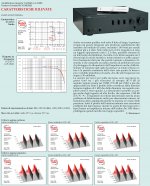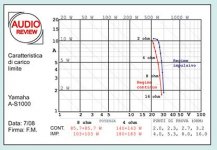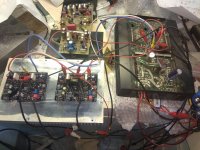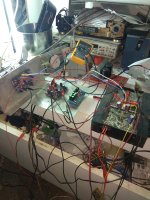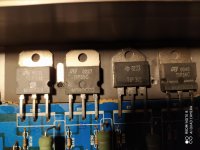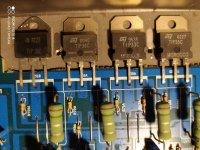Mismatched output transistors that are in parallel won't generally affect the sound (remember the global feedback) but it can affect the reliability when the amp is driven to its limits
i see ... the NGF takes care of everything ... ok no more doubts
Speaking of the amperes the max current delivered by an amp is very important because it tells about its driving ability of difficult loads
For instance two amps can have the same power on 8 ohm load ... but passing to 4 ohm load one can have more or less the same power and another one can double it. Usually the second one sounds more powerful in the bass.
It can deliver more current on a 4 ohm load while showing the same power on 8 ohm
This is the reason why some less powerful amps can sound more powerful that amps with higher wattage on 8 ohm ... because their current do not sag
Usually this is the result of some kind of current limiting circuit. They limit the current to limit the heatsink needs ... the parts grade ... i do not know why
There is an italian magazine doing this kind of test ( i am attaching a lab report)
Considering that the impedance curve of an average speaker can dip down to 4 ohm often i usually look to the power on 4 ohm .. or even 2 ohm I understand not many amps are stable on a 2 ohm load
if you do not test you do not know the power ... if an amp is stable Testing is fundamental in generalWhy is testing important? (showstopper?)
But the showstopper i was referring to is the fact that you mentioned that cables routing can have a huge impact on performance
I cannot accept the idea that if i move let's say a power wire the sound changes
It seems that this kind of amps is very sensitive indeed.

Attachments
Last edited:
You're mixing two things (at least). The ability of an amp to double the power in 1/2 the load isn't generally about the current capacity but the regulation of the rail voltage. The downside of this is that you limit the power into the higher impedance load to double the power. More snake oil.
You were talking about testing THD+noise. That's FAR different than testing for power. Power testing is relatively simple. You'll need a dummy load and a scope. THD+noise, you typically need a computer with a high-end sound card or a standalone piece of test equipment.
You were talking about testing THD+noise. That's FAR different than testing for power. Power testing is relatively simple. You'll need a dummy load and a scope. THD+noise, you typically need a computer with a high-end sound card or a standalone piece of test equipment.
You're mixing two things (at least). The ability of an amp to double the power in 1/2 the load isn't generally about the current capacity but the regulation of the rail voltage ...
Do you mean that what really sags is the power supply and not the output stage ? of course if the current is not limited by design with some kind of protections ? Thanks a lot now i understand much better.
Regarding the measurements no doubts ... i understand the points very well.
Due to various losses in the circuit, the rail voltage drops as the load decreases in impedance, unless it's tightly regulated (really pointless, in most amps).
If you had a 2 ohm amp that was driven to full power (just before clipping) into 2 ohms and increased the load to 4 ohms or opened the load (no load), there would be no noticeable (and barely any measurable) difference in the signal at the speaker terminals.
If you had a 2 ohm amp that was driven to full power (just before clipping) into 2 ohms and increased the load to 4 ohms or opened the load (no load), there would be no noticeable (and barely any measurable) difference in the signal at the speaker terminals.
Due to various losses in the circuit, ...
if i understand well when the load impedance goes down the output stage has to deliver more current and then asks more current to the power supply
If the power supply cannot deliver that current the supply voltage sags ?
i have been advised to do a very simple test ... to put an analogue voltmeter across the PS caps and watch the needle ... as long as it does not drop everything is fine
do you mean an amp stable on 2 ohm ? that is really low indeed I really thing it would be better to avoid loads so low ... a very demanding loadIf you had a 2 ohm amp ...
Maybe having more output devices in parallel can improve the performance on very low loads ? if so that is also a very good point in favour of the paralleled output pairs design choice
I will study the link of switching power supplies you kindly provided to me even if i am very slow to understand things
My guess is that the last generation of smps should be much better also for audio purposes

I would like to thank you again for the very important lessons ... also the one about the preamps setting the sound as long as the power amp is rightly design. This is a very important point for me and mirrors my listening experience. I mean ... using the same preamp with different power amps provides very similar sounds ... much more than otherwise i.e. using a same power amp with different preamps (tubes in particular)
Last edited:
For most every amp, when the amp sends more power to the speakers, the rail voltage will drop. The drop will correspond to the power driven to the speakers. The rail voltage dropping means very little unless it collapses to nothing.
2 ohm 'stable' amps are the norm.
The term 'stable' was made up by marketing. In design, the term stable is used to express the amp circuit's resistance to misbehaving like oscillation.
I don't know if you're confusing the switching power supply in the amp and the external 12v power supply that uses switching to convert the voltage from mains to 12v.
2 ohm 'stable' amps are the norm.
The term 'stable' was made up by marketing. In design, the term stable is used to express the amp circuit's resistance to misbehaving like oscillation.
I don't know if you're confusing the switching power supply in the amp and the external 12v power supply that uses switching to convert the voltage from mains to 12v.
... I don't know if you're confusing the switching power supply in the amp and the external 12v power supply that uses switching to convert the voltage from mains to 12v
actually here we have two power supplies in series ... the smps providing the 12VDC and the dc-dc converter inside the power amp generating the dual voltage supply
And this actually confuses me a little more than usual
I still do not know precisely how to determine the current needed at 12VDC to power an amp properly ... i am aware that it depends on the amp's power but still it is not clear to me how to calculate the amperes
But 12VDC smps with high currents are quite available
Another one is coming ... too cheap to let it go
Alimentatore stabilizzato 12V 20A - Elettrodomestici In vendita a Roma
when i see Meanwell i cannot stop myself ... i respect the brand very much
I am preparing for the future
Last edited:
We already covered current needed. The amps are about 50% efficient at full power. If you have a 100W amp running at full power, it's going to need 200w from the power supply.
At less than full power, it will require less from the 12v supply. At idle, it will require only about 1 amp of current.
At less than full power, it will require less from the 12v supply. At idle, it will require only about 1 amp of current.
Thanks ! actually it is a lot indeed ... better not to exaggerate with amp's power then 
No more questions ... i have also another one smaller amp and less powerful ... i will start with that one ... it seems that people in the car audio switch amps quite often Very good !
Very good ! 
Kind regards, gino
No more questions ... i have also another one smaller amp and less powerful ... i will start with that one ... it seems that people in the car audio switch amps quite often
Kind regards, gino
2 ohm is only common when people put multible subwoofer drivers in paralel to produce very loud bass in their car.
Dont worry about wire-routing. Just connect plus to + and minus to -. put a lead from + to "remote" if you you dont have a 12 volt remote trigger signal from your preamp. Otherwise it wont power up.
Be prepared for noise when you power up. - Efficient speakers sound more noisy than less efficient ones - Moreso with a powerfull amplifier.
Noone knows if your amplifier has been repaired. Could very well be as new.
To learn modications you should just find an amp in a dumpster. Higher chance of hearing a difference when modifiying low quality amps.
Cheers!
Dont worry about wire-routing. Just connect plus to + and minus to -. put a lead from + to "remote" if you you dont have a 12 volt remote trigger signal from your preamp. Otherwise it wont power up.
Be prepared for noise when you power up. - Efficient speakers sound more noisy than less efficient ones - Moreso with a powerfull amplifier.
Noone knows if your amplifier has been repaired. Could very well be as new.
To learn modications you should just find an amp in a dumpster. Higher chance of hearing a difference when modifiying low quality amps.
Cheers!
2 ohm is VERY common with 'highs' amps. It's common to use two 4 ohm speakers per channel. You can even buy 2 ohm coaxials/triaxials to get full power from a single speaker.
For subs, few amps are only rated to go down to 2 ohms. Most go to 1 ohm and that's how people run them. Many run lower than safe (1/2 ohm).
Modern amps have muting circuits and should be virtually completely noise free on startup.
The amp's power rating/output has very little to do with the noise level.
The photos he posted were of a 2 channel amp that used two transistors per phase (high-side/low-side) per channel. I've never seen an amp that would mix a TIP33 and a TIP35 for a single phase. Mismatching parallel transistors is going to decrease reliability.
For subs, few amps are only rated to go down to 2 ohms. Most go to 1 ohm and that's how people run them. Many run lower than safe (1/2 ohm).
Modern amps have muting circuits and should be virtually completely noise free on startup.
The amp's power rating/output has very little to do with the noise level.
The photos he posted were of a 2 channel amp that used two transistors per phase (high-side/low-side) per channel. I've never seen an amp that would mix a TIP33 and a TIP35 for a single phase. Mismatching parallel transistors is going to decrease reliability.
Last edited:
Hi ! i got lost in another topic of a tube buffer i got. I promise at least some more pics within today However it looks like the power amp has been repaired.
I think a lot and do little ,,, but i see so many car amps thrown away by fanatics that are looking always for the more powerful one. And looking inside they look very well designed and built. And a weird idea comes to me. That is bypass the psu and use instead a classic transformer plus a diodes bridge I am even thinking of cutting the board and separate the psu from the amp circuit section. I could always get back with some thick wires as bridges between the two sections.
I will upload some more pics of the output stages. Promised.
I think a lot and do little ,,, but i see so many car amps thrown away by fanatics that are looking always for the more powerful one. And looking inside they look very well designed and built. And a weird idea comes to me. That is bypass the psu and use instead a classic transformer plus a diodes bridge I am even thinking of cutting the board and separate the psu from the amp circuit section. I could always get back with some thick wires as bridges between the two sections.
I will upload some more pics of the output stages. Promised.
sorrySo you didnt listen to it yet? Cheers!
Hi ! sorry if i jump in but i really need some advice on car audio amps.
First of all i have absolutely no experience with car audio.
I do not listen when i drive for safety reasons (the music distracts me a lot).
Anyway ... i see many car audio amps around ... new and used.
So i thought about using one of them as a power amp in my stereo system.
I have already bought this to power it ...
LEDMO 12V 20A Alimentatore Interruttore AC 110/240V to DC Trasformatore di Alimentazione 240W: Amazon.it: Fai da te
One thing that i like very much is the gain control that can be found on i guess all car audio amp. I have a preamp with a high gain and that attenuator could be very useful for me.
So the question is ... what to buy ? i really need only 20-30 Watt/channel but with good current
Any advice and suggestion would be very welcomed and appreciated.
Kind regards, gino
Howdy,
I used a modified Milbert BaM230 tube car audio amp using a 12V switch mode power supply and car battery, while working overseas many years back.
Had a modified (with real Black Gate caps) portable Radio Shack Optimus 3400 CD player driving it through some MIT CVT Terminator interconnects and speaker cables. Speakers were Sequerra Met 7 MkII mini monitors on top of the ends of a long furniture cabinet. Quite musical, especially with well-recorded CDs. Fairly compact system.
Another time, working stateside away from home, had the Milbert amp driven by the tiny Sony XDR-HDF1 tuner. Used some Audience 2+2 speakers on speaker stands. Great tuner. Sound was pretty good, but would've have been better with a good CD player (the Radio Shack portable died a natural death in the interim years). Not enough room to get more elaborate, set-up wise.
I would stick with home audio components when at home. There's always good used stuff available. But if you can only have one transportable system for car or home, you can certainly do it. It's a bit of trouble, but can make life much more pleasant when on the road. The Meridian F80 is a pretty nice all-in-one portable that can be used with all domestic voltages worldwide.
I'm sure a GOOD solid state car audio amp would be fine as well. Just make sure to use as good a power supply as possible. Outside of an old original ADS plate amp back in the day, I've never owned (or wanted) another one since getting a Milbert.
Happy Hunting!
By the way, I just tried an old scrathed up VDO cd 4802 headunit that someone gave me years ago. Now it sounds like a thousand dollar stereo with blown front speakers and the original backdoor speakers. Aperently it has build in room corection even its a 2002 model. Will put in some 6x9s as subwoofers and tangband fullranges ontop of the dashboard to see how it sounds. Headunit can drive the subs,, so I will try without amplifier first.
Cheers!
Cheers!
I'm using 1/2 of car amplifier for power supply!
Just the smps.
A 220/12V transformer, a bridge rectifier, the smps of car amplifier and a lot of amplifiers!
Poor man's power supply!
Just the smps.
A 220/12V transformer, a bridge rectifier, the smps of car amplifier and a lot of amplifiers!
Poor man's power supply!
Attachments
Last edited:
Hi ! sorry for the slow replies ... i have issue with my job 
anyway ... i am attaching the pics of the output stages I was surprised to see different bjts

in the meantime i have bought 5 pairs of tip35c and tip36c with the intention of replacing the ones in the amp
Is this stupid ? at least they will be identical
In my mind the output stage is 2 pairs paralleled ... am i wrong ?
anyway ... i am attaching the pics of the output stages I was surprised to see different bjts
in the meantime i have bought 5 pairs of tip35c and tip36c with the intention of replacing the ones in the amp
Is this stupid ? at least they will be identical
In my mind the output stage is 2 pairs paralleled ... am i wrong ?
Attachments
Last edited:
- Status
- This old topic is closed. If you want to reopen this topic, contact a moderator using the "Report Post" button.
- Home
- General Interest
- Car Audio
- Anyone using a car audio amp in a home stereo set-up?
